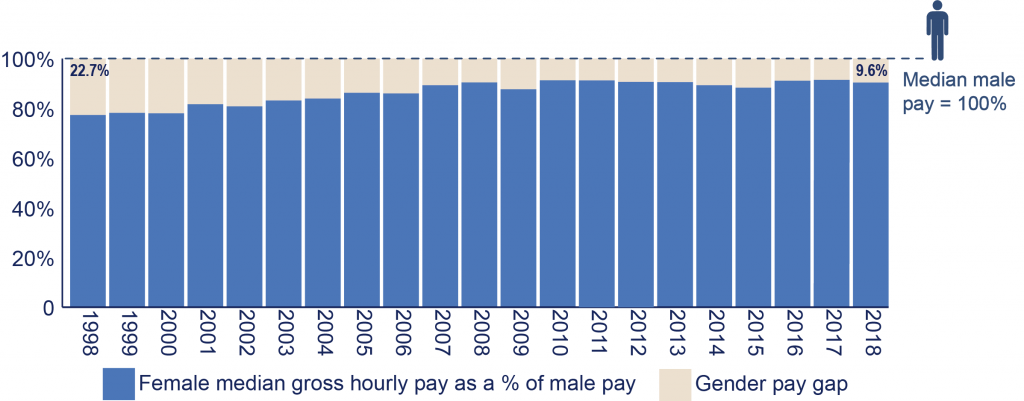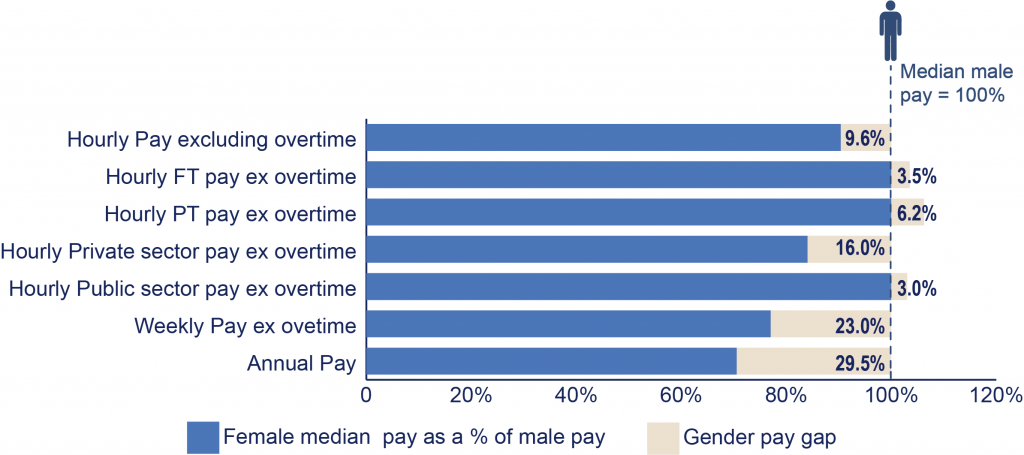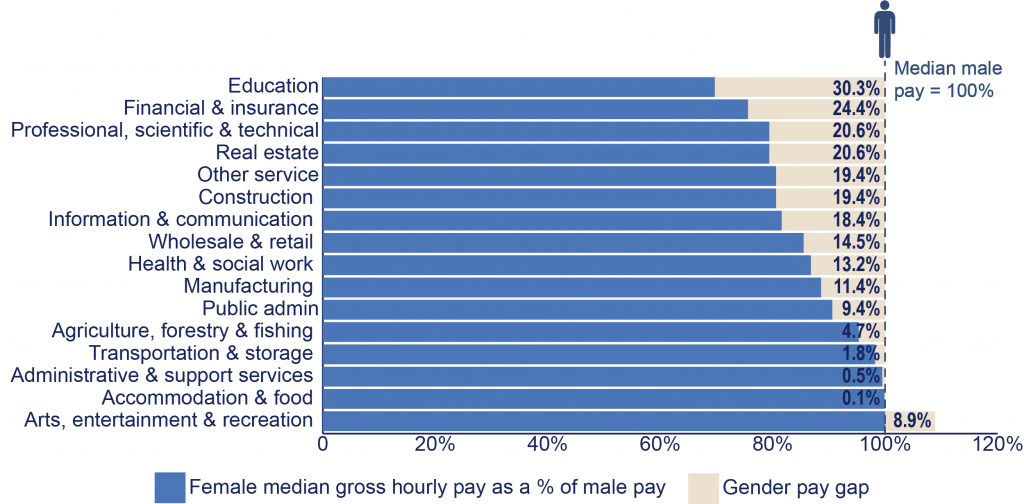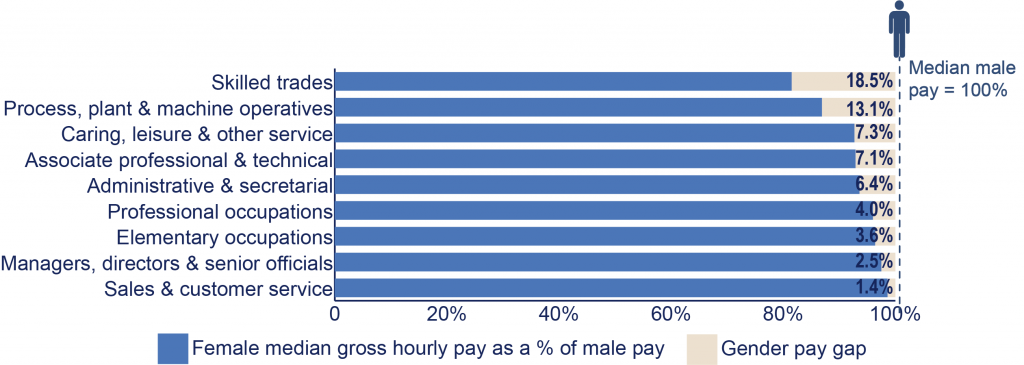By Michael Scholes & Aidan Stennett
To highlight International Women’s Day, this blog article updates a previous one examining the Gender Pay Gap in Northern Ireland, by presenting the latest 2018 data.
The UK Government defines the gender pay gap (GPG) as:
… the difference between the average earnings of men and women, expressed relative to men’s earnings. For example, ‘women earn 15% less than men per hour’.
The GPG should not be confused with equal pay, which refers to paying men and women differently for doing the same work. This discriminatory practice was outlawed in the UK by the Equal Pay Act 1970.
There are a number of factors which lead to a GPG. Again, these are defined by the UK Government as:
- A higher proportion of women choose occupations that offer less financial reward (e.g. Administration), whilst many high paying sectors are disproportionately made up of male workers (e.g. Information and Communications Technology);
- A much higher proportion of women work part-time, and part-time workers earn less than their full-time counterparts on average; and,
- Women are less likely to progress up the career ladder into high paying senior roles.
The reasons for these factors are complex and overlapping. However, research, such as work carried out by the Institute for Fiscal Studies (IFS), shows that certain elements recur in the literature:
- Work by the IFS found that the pay gap widens in the late 20s, with male wages increasing and female wages flat-lining. This is, the IFS believes, a result of women having children. Following this, the gap continues to widen as women lose out on labour market experience, lowering their future wage potential;
- Women also tend to enter part-time employment following the birth of their first child, reflected in the high number of women working part-time. This part-time working also appears to be persistent. Even after a child has reached the age of 20, women are more likely to remain in part-time employment, potentially reflecting the impact of a loss of labour market experience; and,
- Choice of occupation, as noted above by the UK Government, also plays an important role in the development of a gender pay gap. In broad terms, women tend to work in lower paying sectors.
Importantly, and as noted by the IFS, this does not explain the wage gap prior to the arrival of a woman’s first child.
Measuring the GPG
There are various ways to measure the average earnings of men and women. The Office for National Statistics (ONS) and the Northern Ireland Statistics and Research Agency (NISRA) prefer to use median hourly pay excluding overtime. In their view, overtime can often distort the picture as more men than women tend to work overtime. The median is preferred because using the mean (another measure of averages) can misrepresent the data due to small numbers of very high earners. NISRA also asserts that using hourly earnings ‘…better accounts for the fact that men work on average more hours per week than women’.
GPG in Northern Ireland
The GPG has been a consistent concern for the Northern Ireland labour market. However, PWC’s Women in Work Index, published in 2018, states that of all the United Kingdom (UK) regions, Northern Ireland has seen the largest narrowing of its GPG since 2000. This improving picture was also reflected in the recent Northern Ireland Annual Survey of Hours and Earnings (ASHE). This survey shows that in Northern Ireland, female and male earnings are more closely aligned than in other parts of the UK.
Figure 1 provides a summary of the Northern Ireland gender pay gap since 1998.

As figure 1 shows, using the measure of hourly pay for all employees (full-time and part-time) reveals that there was a 9.6% pay gap in Northern Ireland during 2018. This has narrowed from 22.7% in 1998, but has widended since 2017, when the gap was 8.6%.
Put simply, the latest data shows that in terms of median pay in 2018, for every £1 earnt by a male employee, a female employee earnt 90.4 pence.
However, when we look at hourly pay separated out into full time (FT) and part time (PT) employment, the picture becomes more complicated, as both FT and PT appear to produce a reverse GPG, in which women earned more than men.
Figure 2 illustrates this apparent conundrum in Northern Ireland GPG over different employment periods. It also shows how the GPG differs in the public and private sectors in Northern Ireland.

As we see from Figure 2, a pay gap was evident in male and female hourly pay, exluding overtime, with females earning 9.6% less than males. Despite this, there was a reverse GPG in Northern Ireland for both hourly FT and PT pay. The data shows that in 2018 median hourly female FT pay was 3.5% greater than the male equivalent. Similarly, median hourly female pay was PT 6.2% greater than the male equivalent. NISRA explains that the main reason for this is due to the ‘part-time effect’:
The inclusion of part-time employees increases the gender pay gap as part-time employees earn less on average than full-time employees […] and a higher proportion of part-time employees are women.
In order words, because more females occupy more part-time jobs than males, and these jobs tend to be lower paid than full-time jobs, this has the effect of increasing the overall GPG in Northern Ireland. For an animated explanation of the ‘part-time effect’, please click here.
Figure 2 also shows the GPG was much greater in the private sector (16%) than the public sector. In the former, females were found to earn 3% more than men. Drilling down in the data shows even greater variation in the GPG found in specific industry sectors and in specific types of occupation.
Figure 3 shows the median and part-time hourly earnings, excluding overtime for 2017, while using the standard industrial classification (SIC) of economic activities.

In 2018, females earned less than males in 15 of the 16 groupings. There was a reverse GPG only in the arts, entertainment and recreation classification. The widest gap was in the Education group.
Figure 4 shows the median full-time and part-time hourly earnings, excluding overtime for 2017, while using the level 1 standard occupational classification (SOC).

In 2018 females earned less than men in all of the nine occupation groups. The GPG was widest for skilled trades. This also was the group with the smallest number of females employed (over 90% of those employed in this grouping were male). The narrowest GPG was in sales and customer service occupations.
To conclude, it is evident, based on the 2018 data, that although the overall gap between male and female pay has narrowed in Northern Ireland since 1998 (as measured by the ONS preferred measure – median hourly pay excluding overtime), the gap in pay still remains. It is also evident that the GPG was not equal across industry or job type. Specific industry sectors had a much wider pay than others, whilst one (arts, entertainment and recreation) demonstrated a reverse GPG. Similarly, the gap between male and female earnings in specific occupations revealed considerable variations. The evidence presented above shows that the GPG in Northern Ireland is still an issue that needs to remedied.

